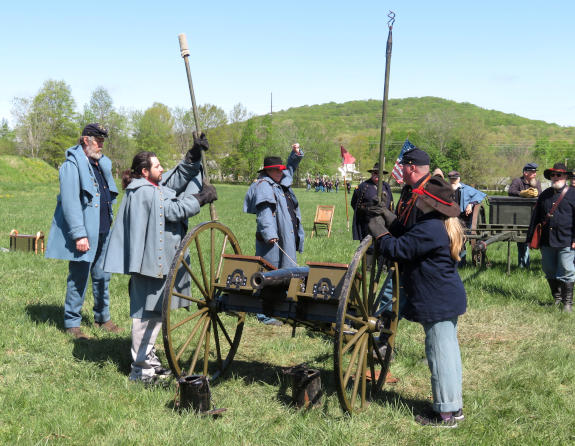The Barleycorn Boys Campaigner’s Corner
THIS OLD SHEBANG
by (Bvt. Sgt.) Pvt. Mike Palada
No, you won’t find This Old Shebang coming anytime soon to your local PBS station with Steve, Norm, and the rest of the crew demonstrating the latest and greatest in power tools, building supplies, and construction techniques. Instead, the concept is left to your humble correspondent to present in this installment of the Campaigners’ Corner.
“What in Hades is a shebang?” some of you might ask. Well friends, simply put a shebang was a very temporary improvised shelter constructed while on campaign or in bivouac when the canvas and barracks of the garrison or permanent camp were not to be had. Call it a lean-to, shelter, or hog pen; by any other name it is still a shebang.
Contrary to popular belief, authentically portraying the Federal soldier on campaign does not automatically dictate that one must roast in the sun, float away upon rains of Biblical proportions, wallow in seas of mud, or otherwise succumb to the less desirable elements of nature. True, while for the campaigner these experiences are sometimes unavoidable, the resourceful soldier may find a humble abode in any form of a shebang that his energy and imagination will allow him to fashion.
“Well that’s fine and dandy,” you say, “but just how do I get started building my shebang?”
Well, friend, the environment of your bivouac will determine how and what you build your shelter out of. Too, the weather situation is a key factor. For this instance, this writer will describe the processes that went into the following shebang built and used at an event this past November at the Carnton Plantation in Franklin, Tennessee. Note the accompanying picture. This shebang was built by your humble correspondent in about 45 minutes. A good pard or two will cut that time in half and equal out the division of labor. No tools nor mechanical fasteners were used in its construction, save for a pocketknife-and an exceedingly dull one at that.

M. Palada resides in his shebang in Franklin, TN. Image struck by Diane Zelinske.
The weather situation at Franklin was cold (mid 30’s to low 40’s during the day), raining (pretty much all day Friday with a threat of snow flurries or sleet Saturday), and an ever welcoming field of Tennessee mud. Perfect weather in which to submit a campaign impression, right? You bet.
First-off, one must select a site for his dwelling. It is advisable to stake claim near or in a tree line or in a wooded area if at all possible. The effect of this is to act as a wind block on windy or stormy days while also serving to provide a much more shady area on those balmy, sun-drenched afternoons. This also puts one and his mess mates in close range to the building materials needed to construct their shebang.
Framing it up. Right, the site having been surveyed and selected, the next step is to erect a basic frame that will support the canopy of the shelter. The aforementioned shebang used two forked uprights and a third limb as a ridgepole (all of which were downed limbs thus negating the need for an ax or hatchet), just as if one was setting up a dog tent. If the uprights cannot be stuck fast into the ground, an extra pair of hands holding up the frame is helpful until the back frame is added which will then serve as a brace. In framing out the back, simply lay more limbs on one side and over the ridgepole, allowing them to slant backwards to the ground. Once more, forked limbs work best as the forked end can be secured by jamming it up against the ridgepole. These should be spaced about every 8-10 inches. This assembly will be the rafters of your new home’s roof. On mild, warm, and pleasant weather outings, this skeleton is adequate enough. However, in this example do to the hostile weather already intimated, the above procedure was continued by wrapping around the ends, both fore and aft, thereby enclosing most of the front or open side as well. The remaining opening in front was buttoned up by way of a rubber blanket which ministered as the front door.
Upon completion of your shelter’s frame, the roof and sides (if practicable) should be covered. It is this writer’s experience that small limbs awash with broad, flat, leafy vegetation do the job admirably. No succinct directions need be given as to their placement. The soldier’s chief concern in their strewed situating being that they are layered upon one another in an overlapping fashion. Again, if perchance the specter of wet weather is nigh, the more the layers of such material heaped together the better. As with this example, an additional top-coat of hay was liberally used-its presence much aiding in the wicking away of excessive moisture, like water off a duck’s…. Pine boughs also do nicely with the same effect. All that is left is to spread a little bedding-leaves, straw, or pine needles on the floor if need be and take delight in your humble yet authentic domicile.
One’s and his mess mates’ imagination and surroundings are the only limitations when it comes to constructing a shebang. Other examples witnessed by your humble correspondent while on duty with the hardcore Army of the Pacific at last October’s Perryville event, included one such brush shelter that housed an entire 32-man company, a colossal shebang of mere rubber blankets and shelter halves, smaller mess sized hog pens entirely out of fence rails, as well as a much more modest and humbler shebang occupied by this writer and his chums which exhibited a rubber blanket front portico columned by inverted muskets stuck fast in the ground thanks to the bayonet. A haunting sight it was to see as an entire 600-man brigade (two battalions) was flying hither and thither, scattering pell-mell in a Kentucky wood lot assembling their shebangs in an unrelenting downpour.
Questions, comments, concerns? Fan-mail, hate-mail, something you want to see in a future installment? Bend my ear around the fire over it or wire it to me at TheBarleycornBoys@military.com Omnia mea mecum porto. Bully!
By the by, aye the truth be told, this writer did live in the pictured shelter for the entire weekend and slept very much dry and warm by means of one army blanket and overcoat along with a muffler and period mittens knitted by a special someone back home (no long johns or other winter weather attire). This shebang shed water but yet retained the body heat of its inhabitant. It works! Still don’t believe me, try it yourselves sometime.
This article was originally published in the July-August 2003 issue of The Shrapnel, the newsletter of the Turner Brigade. For information about The Shrapnel, contact Sheila Porter, Editor.



